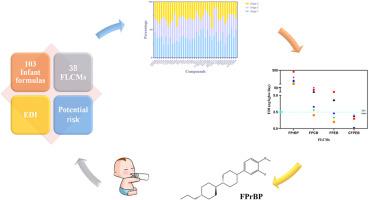当前位置:
X-MOL 学术
›
Environ. Pollut.
›
论文详情
Our official English website, www.x-mol.net, welcomes your
feedback! (Note: you will need to create a separate account there.)
Fluorinated liquid-crystal monomers in infant formulas and implication for health risk
Environmental Pollution ( IF 7.6 ) Pub Date : 2024-07-02 , DOI: 10.1016/j.envpol.2024.124502 Runqing Liu 1 , Runhui Yang 2 , Qian Jiang 2 , Bing Shao 3
Environmental Pollution ( IF 7.6 ) Pub Date : 2024-07-02 , DOI: 10.1016/j.envpol.2024.124502 Runqing Liu 1 , Runhui Yang 2 , Qian Jiang 2 , Bing Shao 3
Affiliation

|
Fluorinated liquid-crystal monomers (FLCMs), a new class of potential persistent, bioaccumulative and toxic (PBT) emerging pollutants, are extensively utilized in the display panel of various electronic devices. These compounds have been found in various environmental matrixes and dietary. Our previous studies have documented their ubiquitous occurrence in high fat foodstuffs. Infants, a vulnerable group, are more susceptible to the impacts of these pollutants compared to adults. Herein, we provided an assessment of the health risks posed by FLCMs to infants, focusing on their exposure through infant formula. The presence of FLCMs was detected in all infant formulas, with median concentration of 16.5 ng/g dry weight (dw) and the 95th percentile concentration of 65.7 ng/g dw. The most prevalent pollutant in these formulas was 2-fluoro-4-[4′-propyl-1,1′-bi(cyclohexyl)-4-yl] phenyl trifluoromethyl ether (FPrBP), with median and a 95th percentile concentration of 12.2 ng/g dw and 23.8 ng/g dw, accounting for 55.2% to the total FLCMs. Infants aged 0–6 months had the highest estimated daily intakes (EDIs) of FLCMs, with the EDImedian of 267 ng/kg bw/day. FPrBP and 4-[trans-4-(trans-4-Propylcyclohexyl) cyclohexyl]-1-trifluoromethoxybenzene (PCTB) together made up 83.3% of the total EDIs in median exposure scenario of 0–6 months infant. The highest EDI value was 1.30 × 103 ng/kg bw/day, 77.1% of which was attributed to a combination of FPrBP, 4″-ethyl-2′-fluoro-4-propyl-1,1':4′,1″-terphenyl (EFPT), 2-[4'-[difluoro(3,4,5-trifluoro-2-methyl-phenoxy)methyl]-3′,5′-difluoro-[1,1′-biphenyl]-4-yl]-5-ethyl-tetrahydro-pyran (DTMPMDP), 4-[Difluoro-(3,4,5-trifluoro-2-methyl-phenoxy)-methyl]-3,5-difluoro-4′-propyl-1,1-biphenyl (DTMPMDB), 2,3-difluoro-1-methyl-4-[(trans, trans)-4′-pentyl[1,1′-bicyclohexyl]-4-yl]benzene (DMPBB) and PCTB. It's worth noting that FLCMs have higher exposure risk. Based on the threshold of toxicological concern (TTC) method, the EDImedian of FPrBP (183 ng/kg bw/day) and FPCB (3.27 ng/kg bw/day) were beyond their TTC values (2.5 ng/kg bw/day) in 0–6 months infant, implying their prospective health risk.
中文翻译:

婴儿配方奶粉中的氟化液晶单体及其对健康风险的影响
氟化液晶单体(FLCM)是一类潜在的持久性、生物累积性和有毒(PBT)新兴污染物,广泛用于各种电子设备的显示面板。这些化合物已在各种环境基质和饮食中发现。我们之前的研究已经证明它们在高脂肪食品中普遍存在。与成人相比,婴儿是弱势群体,更容易受到这些污染物的影响。在此,我们对 FLCM 对婴儿造成的健康风险进行了评估,重点关注其通过婴儿配方奶粉的暴露。所有婴儿配方奶粉中均检测到 FLCM 的存在,中位浓度为 16.5 ng/g 干重 (dw),第 95 个百分位浓度为 65.7 ng/g dw。这些配方中最常见的污染物是 2-氟-4-[4'-丙基-1,1'-双(环己基)-4-基]苯基三氟甲基醚 (FPrBP),中位数和第 95 个百分位浓度为 12.2 ng/g dw 和 23.8 ng/g dw,占 FLCM 总量的 55.2%。 0-6 个月大的婴儿 FLCM 的每日估计摄入量 (EDI) 最高,EDI 中位数为 267 ng/kg bw/天。在 0-6 个月婴儿中位暴露情况下,FPrBP 和 4-[反式-4-(反式-4-丙基环己基)环己基]-1-三氟甲氧基苯 (PCTB) 合计占 EDI 总量的 83.3%。 EDI最高值为1.30×103纳克/公斤体重/天,77。其中 1% 归因于 FPrBP、4"-乙基-2'-氟-4-丙基-1,1':4',1"-三联苯 (EFPT)、2-[4'-[二氟] 的组合(3,4,5-三氟-2-甲基-苯氧基)甲基]-3',5'-二氟-[1,1'-联苯]-4-基]-5-乙基-四氢-吡喃 (DTMPMDP) , 4-[二氟-(3,4,5-三氟-2-甲基-苯氧基)-甲基]-3,5-二氟-4'-丙基-1,1-联苯 (DTMPMDB), 2,3-二氟-1-甲基-4-[(反式,反式)-4'-戊基[1,1'-双环己基]-4-基]苯(DMPBB)和PCTB。值得注意的是,FLCM 具有较高的暴露风险。根据毒理学关注阈值 (TTC) 方法,FPrBP(183 ng/kg bw/天)和 FPCB(3.27 ng/kg bw/天)的 EDI 中位数超出了其 TTC 值(2.5 ng/kg bw/天) 0-6 个月的婴儿,这意味着他们的潜在健康风险。
更新日期:2024-07-02
中文翻译:

婴儿配方奶粉中的氟化液晶单体及其对健康风险的影响
氟化液晶单体(FLCM)是一类潜在的持久性、生物累积性和有毒(PBT)新兴污染物,广泛用于各种电子设备的显示面板。这些化合物已在各种环境基质和饮食中发现。我们之前的研究已经证明它们在高脂肪食品中普遍存在。与成人相比,婴儿是弱势群体,更容易受到这些污染物的影响。在此,我们对 FLCM 对婴儿造成的健康风险进行了评估,重点关注其通过婴儿配方奶粉的暴露。所有婴儿配方奶粉中均检测到 FLCM 的存在,中位浓度为 16.5 ng/g 干重 (dw),第 95 个百分位浓度为 65.7 ng/g dw。这些配方中最常见的污染物是 2-氟-4-[4'-丙基-1,1'-双(环己基)-4-基]苯基三氟甲基醚 (FPrBP),中位数和第 95 个百分位浓度为 12.2 ng/g dw 和 23.8 ng/g dw,占 FLCM 总量的 55.2%。 0-6 个月大的婴儿 FLCM 的每日估计摄入量 (EDI) 最高,EDI 中位数为 267 ng/kg bw/天。在 0-6 个月婴儿中位暴露情况下,FPrBP 和 4-[反式-4-(反式-4-丙基环己基)环己基]-1-三氟甲氧基苯 (PCTB) 合计占 EDI 总量的 83.3%。 EDI最高值为1.30×103纳克/公斤体重/天,77。其中 1% 归因于 FPrBP、4"-乙基-2'-氟-4-丙基-1,1':4',1"-三联苯 (EFPT)、2-[4'-[二氟] 的组合(3,4,5-三氟-2-甲基-苯氧基)甲基]-3',5'-二氟-[1,1'-联苯]-4-基]-5-乙基-四氢-吡喃 (DTMPMDP) , 4-[二氟-(3,4,5-三氟-2-甲基-苯氧基)-甲基]-3,5-二氟-4'-丙基-1,1-联苯 (DTMPMDB), 2,3-二氟-1-甲基-4-[(反式,反式)-4'-戊基[1,1'-双环己基]-4-基]苯(DMPBB)和PCTB。值得注意的是,FLCM 具有较高的暴露风险。根据毒理学关注阈值 (TTC) 方法,FPrBP(183 ng/kg bw/天)和 FPCB(3.27 ng/kg bw/天)的 EDI 中位数超出了其 TTC 值(2.5 ng/kg bw/天) 0-6 个月的婴儿,这意味着他们的潜在健康风险。
















































 京公网安备 11010802027423号
京公网安备 11010802027423号